REST Service activity
An activity that calls a REST service method from an AgilePoint process. You can select and configure the method call by connecting to a REST service URI.

Configure the REST Service activity
To configure the REST Service activity, do the procedure in this topic.
Examples
Prerequisites
- An operational REST Service.
Good to Know
- In most text fields, you can use process data variables as an alternative to literal data values.
- You can configure whether this activity waits for other activities before it runs.
For more information, refer to How Do I Configure an Activity to Wait for Other Incoming Activities?
- This section shows the configuration settings on the configuration screens for this activity. Other configuration settings apply to system activities. For more information, refer to:
- Some information about third-party integrations is outside the scope of the AgilePoint NX Product Documentation. It is the responsibility of the vendors who create and maintain these technologies to provide this information. This includes specific business use cases and examples; explanations for third-party concepts; details about the data models and input and output data formats for third-party technologies; and various types of IDs, URL patterns, connection string formats, or other technical information that is specific to the third-party technologies. For more information, refer to Where Can I Find Information and Examples for Third-Party Integrations?
How to Start
- Open Process Builder.
For information about how to open this screen, refer to Process Builder.

- In Process Builder, in the Activity Library,
open the Web Services tab.
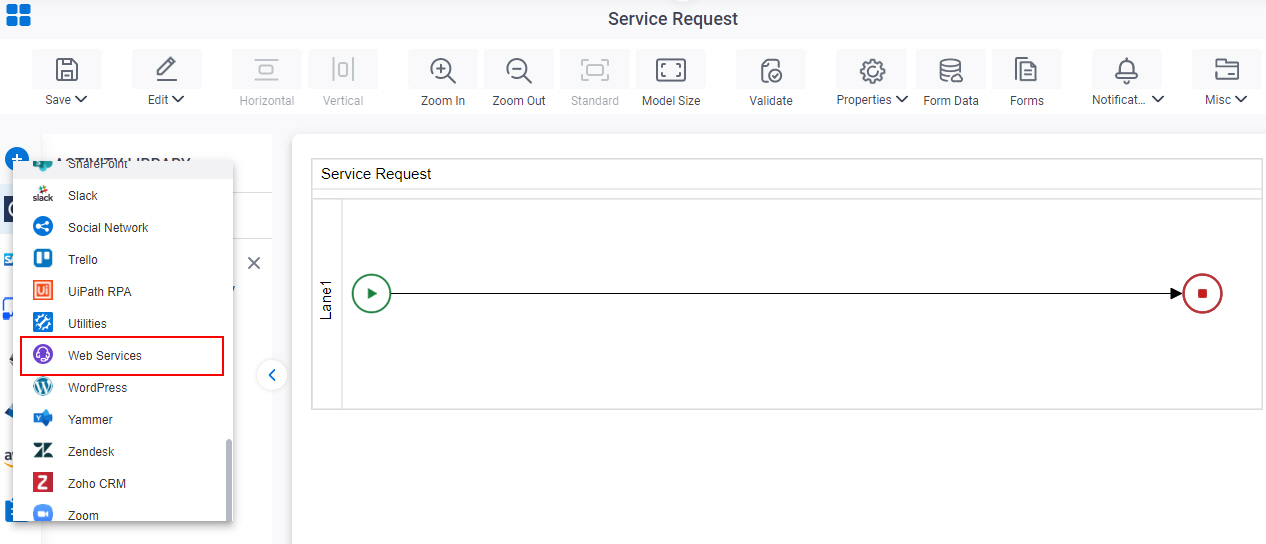
- On the Web Services
tab,
drag the REST Service
activity onto your process.
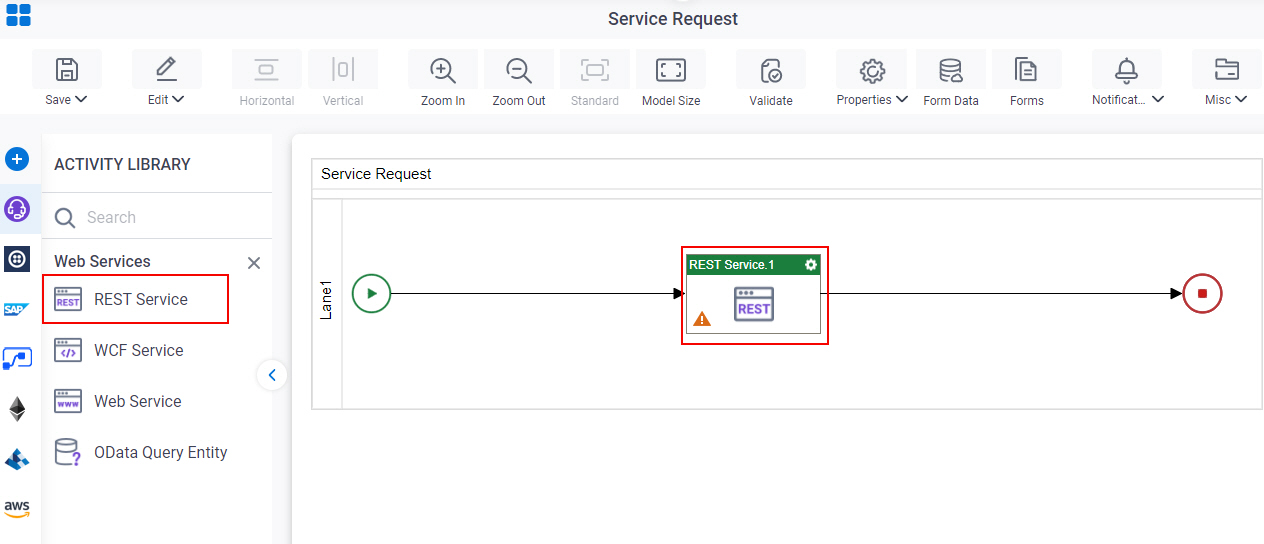
Procedure
- Complete the fields on the
General Configuration screen.
For more information, refer to Configure General Options for Web Service.
- Click REST Access Token
 .
. - On the REST Access Token screen, in the REST Service list, select your REST service access token.
- To connect to the REST service, in the REST Service list, select your REST service access token.
- (Optional) To do advanced configuration for the REST service, do this procedure.
- Select Advanced Configuration.
- Click REST Configuration
 .
. - Complete the fields on the Advanced REST Configuration screen.
- Click REST Request Payload
 .
. - On the REST Request Payload Configuration
screen, do one of these:
- To configure the custom payload details for the REST Service request, do this procedure.
- Select Custom Payload.
- Enter payload values in the box to use when the process runs. The values of the payload must be in JSON/XML format.
- To map the PayLoad with Schema, do this procedure.
- Select Map Payload with Schema.
- In the box, enter the payload values which you want to map from the process schema.
- Click Map Schema.
- On the Schema Mapper screen, map the request columns to the schema elements.
- To configure the custom payload details for the REST Service request, do this procedure.
- Click REST Response
 .
. - Complete the fields on the REST Response Configuration screen.
- (Optional) Click Advanced
 >
Email Notifications
>
Email Notifications  .
.
For more information, refer to Email Notifications screen (Process Activities).
General Configuration
Specifies the basic settings for the REST Service activity.
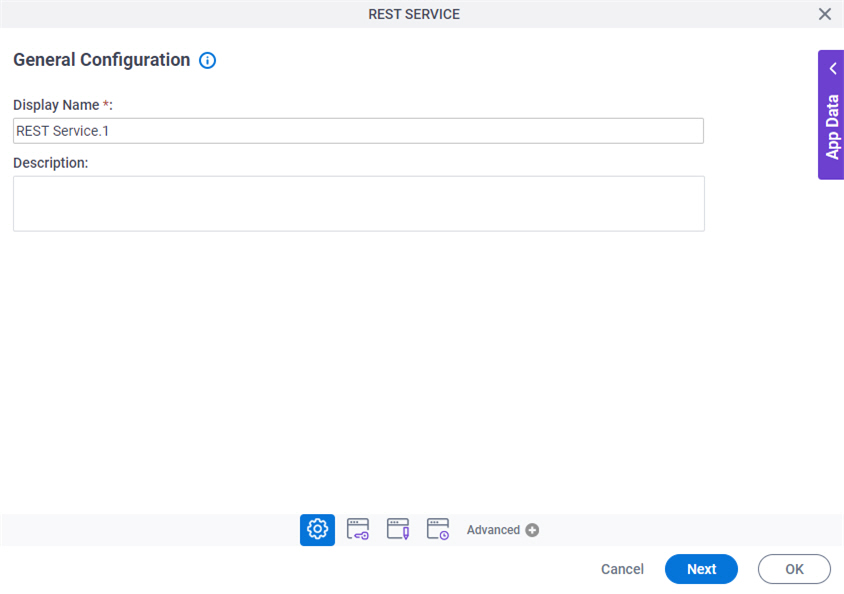
Good to Know
- Documentation for this screen is provided for completeness. The fields are mostly self-explanatory.
Fields
| Field Name | Definition |
|---|---|
|
Display Name |
|
|
Description |
|
REST Access Token Configuration
Specifies the access token or configure the REST service.
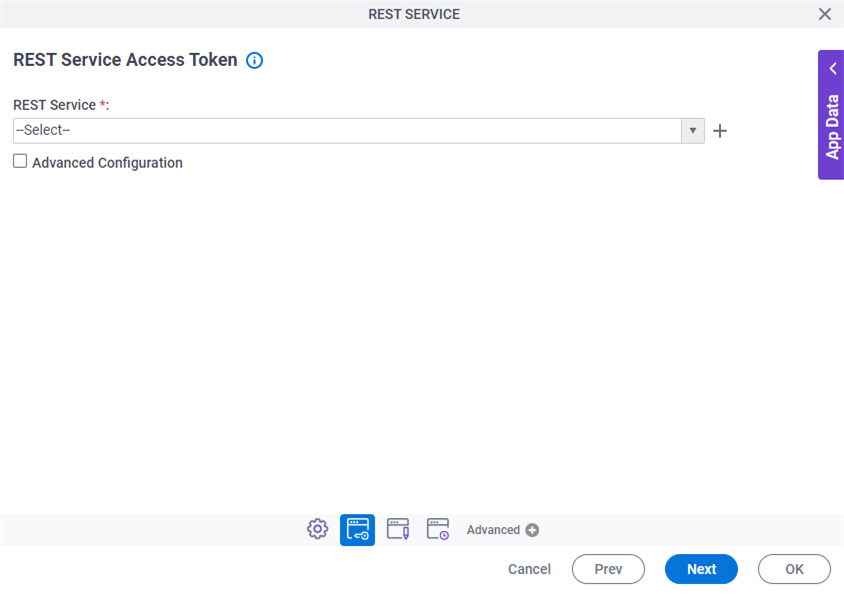
Fields
| Field Name | Definition |
|---|---|
|
REST Service |
|
|
Create |
|
|
Advanced Configuration |
|
Advanced REST Configuration
Specifies the advanced configuration options for your REST service connection.
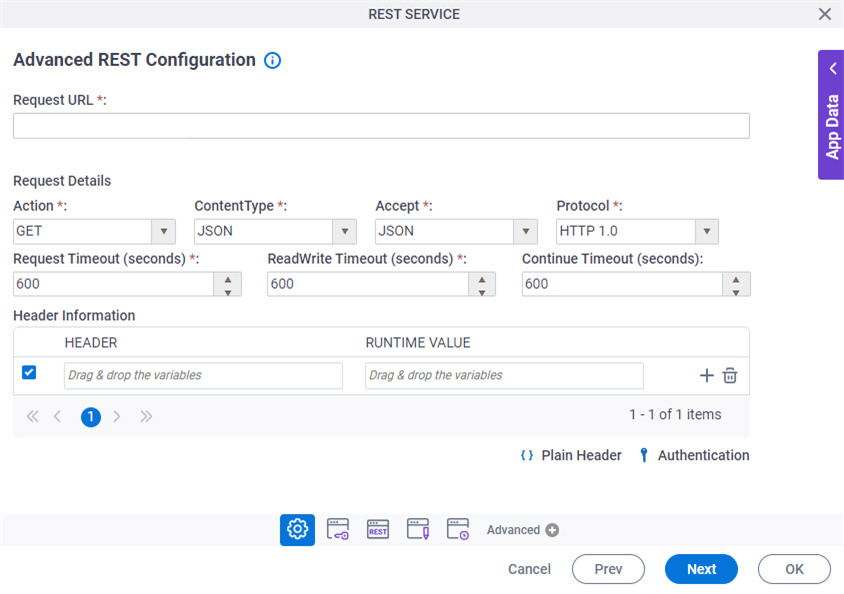
Fields
| Field Name | Definition |
|---|---|
|
Request URL |
|
|
Action |
|
|
Content Type | |
|
Accept |
|
|
Protocol |
|
|
Request Timeout (Seconds) | |
|
Read/Write Timeout (Seconds) |
|
Continue Timeout (seconds) |
|
|
Header Information |
|
Create |
|
Delete |
|
|
Plain Header |
|
Authentication |
|
Advanced REST Configuration > Authentication screen > Basic Authentication tab
Creates REST service authentication credentials to connect to a REST service URL with basic authentication.
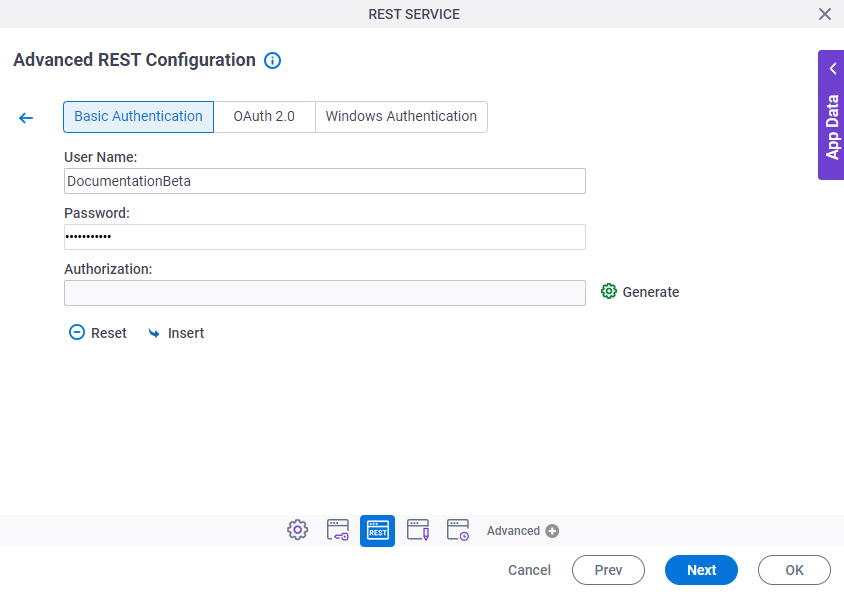
Fields
| Field Name | Definition |
|---|---|
User Name |
|
Password |
|
Authorization |
|
Generate |
|
Insert |
|
Reset |
|
Advanced REST Configuration > Authentication screen > OAuth 2.0 tab
Creates REST service authentication credentials to connect to a REST service URL with the OAuth 2.0 protocol.

Fields
| Field Name | Definition |
|---|---|
Token Type |
|
Token |
|
Advanced REST Configuration > Authentication screen > Windows Authentication tab
Creates REST service authentication credentials to connect to a REST service URL with Windows Authentication (NTLM).

Prerequisites
- AgilePoint NX OnDemand (public cloud), or AgilePoint NX Private Cloud or AgilePoint NX OnPremises v7.0 Software Update 2 or higher.
Fields
| Field Name | Definition |
|---|---|
Domain |
|
User Name |
|
Password |
|
REST Request Payload Configuration
Configures the request payload for the REST service method call with the REST activity.
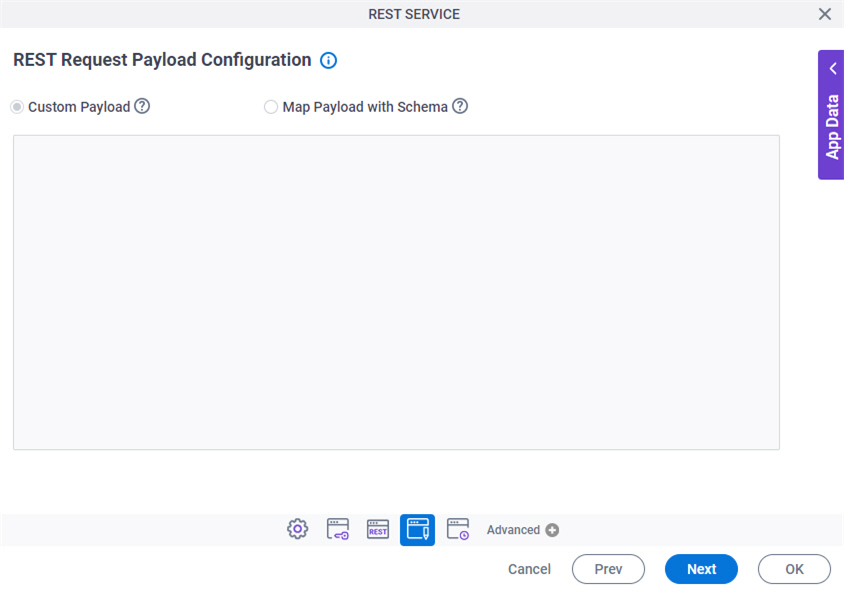
Fields
| Field Name | Definition |
|---|---|
|
Payload |
|
REST Response Configuration
Configures the response settings for a REST service method call with the REST activity.
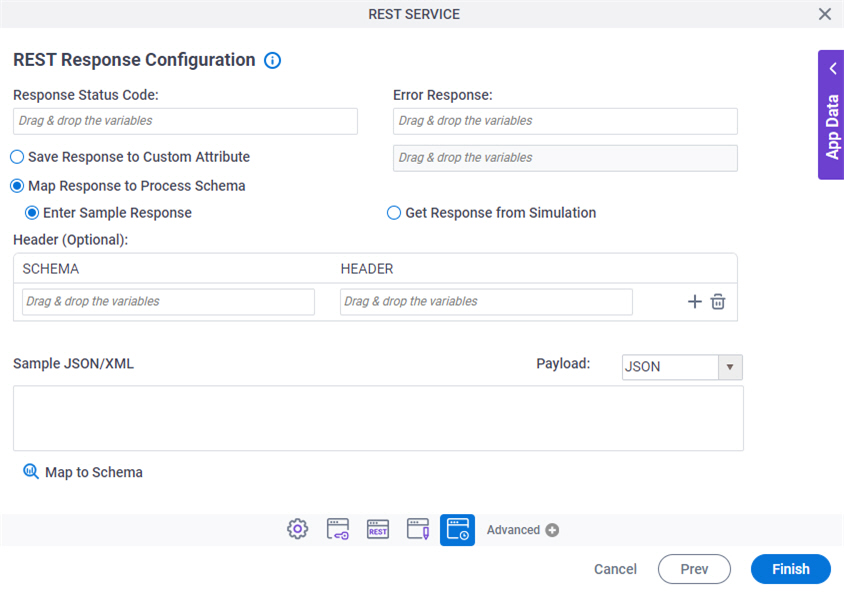
Fields
| Field Name | Definition |
|---|---|
|
Response Status Code |
|
|
Error Response |
|
|
Save Response to Custom Attribute |
|
|
Map Response to Process Schema |
|
|
Header (Optional) |
|
|
Add Header |
|
|
Delete |
|
|
Payload |
|
|
Sample JSON/XML |
|
|
Map to Schema |
|
|
Simulate |
|
|
Ad Hoc Mapping |
|
REST Response Configuration > Simulate
Configures the response settings with a simulated REST method call.
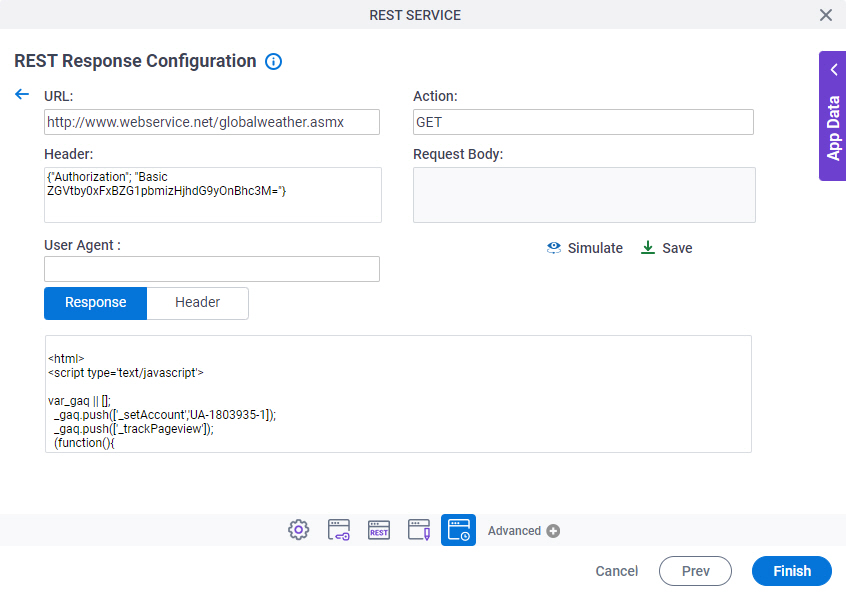
Fields
| Field Name | Definition |
|---|---|
|
URL |
|
|
Action |
|
|
Header |
|
|
Request Body |
|
|
User Agent |
|
|
Simulate |
|
|
Save |
|
|
Response |
|
|
Header |
|
REST Response Configuration > Ad Hoc Mapping
Configures the response settings one at a time.
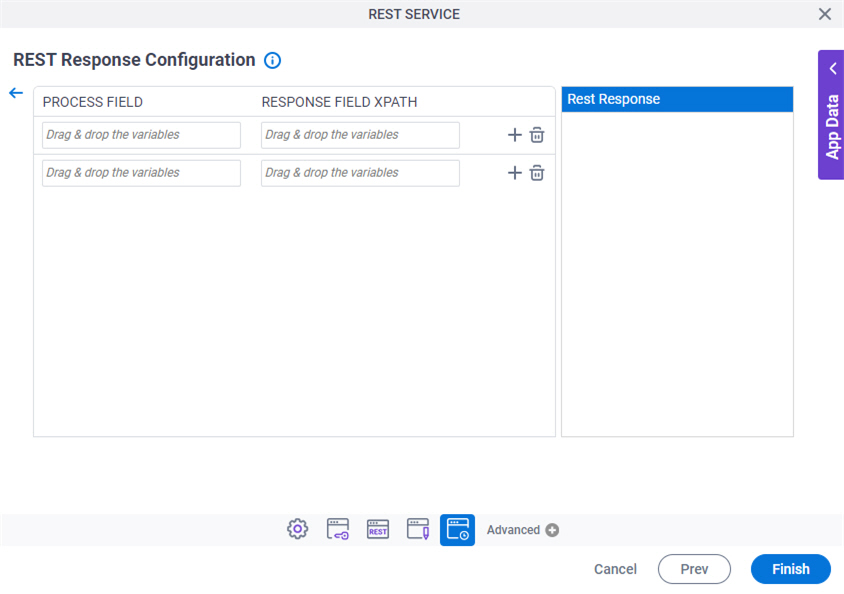
Fields
| Field Name | Definition |
|---|---|
|
Process Field |
|
|
Response Field XPath |
|
|
Add Response Field |
|
|
Remove Response Field |
|



